Installing a new headliner on your boat
Replacing a boat's headliner is a crucial step in maintaining a healthy living environment and improving the appearance and functionality of your cabin.

Installing a New Headliner on Your Boat
Welcome to another informative article in our Boat Modifications and Upgrades section. Today, we will be discussing a crucial aspect of interior design and organization: installing a new headliner on your boat. A headliner is the material that covers the interior ceiling of your boat’s cabin, providing insulation, soundproofing, and a clean, finished appearance. Over time, headliners can become damaged, stained, or simply outdated, making it necessary to replace them. In this comprehensive guide, we will walk you through the process of installing a new headliner on your boat, ensuring that your living space remains comfortable, functional, and aesthetically pleasing.
Table of Contents
Why replace your headliner, choosing the right material, tools and materials needed, preparing the workspace, removing the old headliner, measuring and cutting the new headliner, installing the new headliner, finishing touches, maintenance and care.
There are several reasons why you might want to replace your boat’s headliner:
- Aesthetics : An old, stained, or sagging headliner can detract from the overall appearance of your boat’s interior. Replacing it with a fresh, new material can instantly update and improve the look of your cabin.
- Insulation : A well-insulated headliner can help regulate the temperature inside your boat, keeping it cooler in the summer and warmer in the winter. If your current headliner is not providing adequate insulation, it may be time for an upgrade.
- Soundproofing : A quality headliner can help dampen noise from outside the cabin, as well as reduce vibrations and echoes within the space. If your current headliner is not providing sufficient soundproofing, consider replacing it with a more effective material.
- Mold and Mildew : Over time, moisture can cause mold and mildew to form on your headliner, posing a health risk and creating unpleasant odors. Replacing a moldy headliner is essential for maintaining a healthy living environment on your boat.
When selecting a new headliner material, consider the following factors:
- Durability : Choose a material that is resistant to wear and tear, as well as moisture and UV damage. Vinyl and marine-grade fabrics are popular choices for their durability and ease of maintenance.
- Insulation : Look for materials with insulating properties to help regulate the temperature inside your boat. Foam-backed vinyl and carpet-like materials can provide additional insulation and soundproofing.
- Ease of Installation : Some materials are easier to work with than others. Flexible materials like vinyl and fabric are generally easier to install than rigid materials like wood or fiberglass.
- Appearance : Consider the overall look and feel you want to achieve in your boat’s interior. There are countless colors, patterns, and textures available, so choose a material that complements your existing décor and personal style.
Before you begin the installation process, gather the following tools and materials:
- New headliner material
- Measuring tape
- Scissors or utility knife
- Straight edge or T-square
- Adhesive (appropriate for your chosen material)
- Paint roller or brush (for applying adhesive)
- Staple gun and staples (optional, for certain materials)
- Trim or molding (for finishing edges)
- Screwdriver (for removing and reinstalling hardware)
- Protective gloves and eyewear
Before you begin removing the old headliner, take the time to properly prepare your workspace:
- Clear the Area : Remove any furniture, cushions, or other items from the cabin to create a clean, open workspace.
- Protect Surfaces : Cover the floor and any nearby surfaces with drop cloths or plastic sheeting to protect them from adhesive and debris.
- Ventilation : Ensure that your workspace is well-ventilated, as some adhesives can produce strong fumes. Open windows and doors, and consider using a fan to improve air circulation.
- Safety : Wear protective gloves and eyewear to protect yourself from potential hazards during the installation process.
Before you can install your new headliner, you’ll need to remove the old one. Follow these steps to safely and effectively remove your existing headliner:
- Remove Hardware : Carefully remove any hardware, such as lights, vents, or handrails, that may be attached to the headliner. Be sure to keep track of any screws or other small parts so you can easily reinstall them later.
- Detach the Headliner : Depending on the type of headliner you have, it may be attached with adhesive, staples, or both. Carefully peel back the material, using a scraper or putty knife if necessary to help loosen the adhesive. If your headliner is stapled, use a staple remover or flathead screwdriver to carefully pry out the staples.
- Clean the Surface : Once the headliner has been removed, thoroughly clean the ceiling surface to remove any remaining adhesive, staples, or debris. This will ensure a smooth, even surface for installing your new headliner.
With the old headliner removed and the surface cleaned, you’re ready to measure and cut your new headliner material. Follow these steps for accurate measurements and precise cuts:
- Measure the Ceiling : Using a measuring tape, measure the length and width of your boat’s ceiling, adding a few extra inches to each dimension to allow for trimming and adjustments during installation.
- Mark and Cut the Material : Lay your new headliner material out on a clean, flat surface. Using a straight edge or T-square, mark the dimensions you measured onto the material. Carefully cut along the marked lines with scissors or a utility knife, ensuring that your cuts are straight and even.
With your new headliner material cut to size, you’re ready to begin the installation process. Follow these steps for a successful installation:
- Apply Adhesive : Following the manufacturer’s instructions, apply adhesive to the back of your headliner material using a paint roller or brush. Be sure to apply an even, consistent layer of adhesive, taking care not to leave any gaps or clumps.
- Position the Material : Carefully lift the headliner material and position it on the ceiling, starting at one end and working your way across. Press the material firmly onto the surface, smoothing out any wrinkles or bubbles as you go.
- Trim Excess : Once the headliner is fully adhered to the ceiling, use a utility knife to carefully trim away any excess material along the edges.
- Secure with Staples (Optional) : If your headliner material requires additional support, use a staple gun to secure the edges of the material to the ceiling. Be sure to space the staples evenly and keep them as close to the edge as possible to ensure a clean, professional appearance.
With your new headliner installed, it’s time to add the finishing touches:
- Install Trim or Molding : To create a clean, finished edge along the perimeter of your headliner, install trim or molding. This can be attached with adhesive, nails, or screws, depending on the type of trim and your boat’s construction.
- Reinstall Hardware : Carefully reinstall any hardware that was removed during the headliner removal process, such as lights, vents, or handrails.
- Clean Up : Remove any protective coverings from your workspace and clean up any debris or adhesive residue.
To keep your new headliner looking and performing its best, follow these maintenance and care tips:
- Clean Regularly : Gently clean your headliner with a damp cloth and mild soap, taking care not to saturate the material or damage the adhesive. Be sure to address any spills or stains promptly to prevent permanent damage.
- Inspect for Damage : Periodically inspect your headliner for signs of wear, damage, or mold and mildew. Address any issues promptly to prevent further damage and maintain a healthy living environment on your boat.
- Avoid Overloading : Be mindful of the weight and distribution of items stored in your boat’s cabin, as excessive weight or uneven distribution can cause stress on the headliner and lead to sagging or damage.
Installing a new headliner on your boat is a rewarding project that can greatly improve the comfort, functionality, and appearance of your living space. By following this comprehensive guide, you can confidently tackle this project and enjoy the benefits of a fresh, updated headliner. Remember to choose a durable, high-quality material, and take the time to properly prepare your workspace and follow each step of the installation process. With a little patience and attention to detail, you’ll be well on your way to a beautiful, functional headliner that will serve you well for years to come.
Practical Boat Owner
- Digital edition

Replacing headlinings: How to cure the droop
- Ben Meakins
- February 19, 2016
Are you coming unstuck? If your headlining is starting to part company with the deckhead, it’s time for a makeover. Jake Kavanagh follows professional upholsterer Roger Nantais as he refurbishes a Westerly Seahawk

The biggest enemy of foam-backed vinyl is water. If this leaks in through deck fittings, it can gradually rot the foam; the glue fails to grip on the crumbling mess, and eventually the vinyl will start to fall down. Many owners make valiant attempts to fix the vinyl back up, but this can often create more problems than it solves.
This article deals with linings stuck to hull sides. You can also stick them to removable plywood panels, which we followed in this article: Making Headlining Panels.
On Jane Scott and Chris Smith’s 18-year-old Westerly Seahawk 2+2, a combination of leaking deck fittings and high Mediterranean temperatures had gradually perished the foam backing, and the boat was looking decidedly scruffy inside. They decided to call in professional upholsterer Roger Nantais, who refurbished the linings from stem to stern. PBO followed his progress to learn some useful trade secrets.
Preparation ‘You really need power,’ Roger explained. ‘It’s possible to use hand tools, but the task is made much easier if you can use a hot-air gun, a vacuum cleaner and a drill with a wire brush attachment.’
As a result, the Westerly was moved from her mooring in Poole Harbour to Davis’s boatyard in nearby Hamworthy, where Roger was able to hook up to shore power.
Depending on the state of decay, it may not be necessary to renew all the headlinings at once, but on older boats you could have trouble matching the colours. This Westerly had fairly standard white linings thoughout, complemented by plywood panels on the deckhead in the saloon. In some areas, the original linings were trapped under substantial deck fittings, such as the chain plate bases, which Roger decided to work around.
With the headlinings down, many owners use the opportunity to check hidden wiring, and get to the base of any leaking deck-fittings. These need to be re-sealed before being covered in foam again. We started with the forward cabin first, which was the most badly affected.
Stripping off The forecabin on this boat, as on many similar designs, has a complex headlining made of several panels of vinyl, all sewn together into a contoured piece. It may seem daunting to replace, but the procedure is quite straightforward.

1: All the wooden trims and beadings are unscrewed. These won’t be used again, because the edges they normally hide will be made to look neater with stitching

2: The vinyl panels are peeled back carefully, while trying to keep them in one piece to use as a pattern

3: Any stubborn patches can be loosened with a hot-air gun

4: Before removing a panel, clearly mark its position and orientation – in this case, port lower, with the arrow pointing towards the bow

The hatch trim is unscrewed, and the side facing the bow marked with pencil so the screw holes can be relocated

6: a blade is run around the edges of the window to free the vinyl. The window surrounds will be removed later

7: With the amount of degradation to the foam, the headlining piece comes down easily – and usefully intact

8: The upholsterer will use the old headlining as a template for sewing the panels that will make the new one

9: The window backs are held in place by flush-fitting bolts, which need to be removed from both the outside…

10: …and the inside. This will require two people in the more inaccessible areas. Those shown here present no problem for the solo worker

11: If the window frame is a bit stubborn, it can be prized off with a screwdriver, but be careful not to kink the metal.

12: With the inner frame removed, the vinyl beneath it can be stripped away. Remember to mark the frame in pencil to aid reassembly
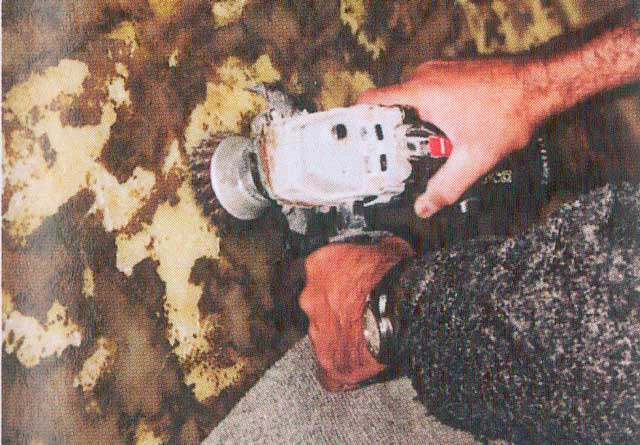
13: With all the vinyl panels marked up and removed, now comes the messy bit. Use the wire brush and hot-air gun to clean off all the old glue and foam. Previous attempts at re-sticking may have resulted in hard patches of glue, which have absorbed some of the crumbling foam. The smoother you can make the inside of the hull, the neater the finish will be. Sweep up with the vacuum cleaner, and make sure you wear a dust mask.
- 1. Introduction
- 2. Relining the cabin
- 3. Tools of the trade

Service Locator
- Angler Endorsement
- Boat Towing Coverage
- Mechanical Breakdown
- Insurance Requirements in Mexico
- Agreed Hull Value
- Actual Cash Value
- Liability Only
- Insurance Payment Options
- Claims Information
- Towing Service Agreement
- Membership Plans
- Boat Show Tickets
- BoatUS Boats For Sale
- Membership Payment Options
- Consumer Affairs
- Boat Documentation Requirements
- Installation Instructions
- Shipping & Handling Information
- Contact Boat Lettering
- End User Agreement
- Frequently Asked Questions
- Vessel Documentation
- BoatUS Foundation
- Government Affairs
- Powercruisers
- Buying & Selling Advice
- Maintenance
- Tow Vehicles
- Make & Create
- Makeovers & Refitting
- Accessories
- Electronics
- Skills, Tips, Tools
- Spring Preparation
- Winterization
- Boaters’ Rights
- Environment & Clean Water
- Boat Safety
- Navigational Hazards
- Personal Safety
- Batteries & Onboard Power
- Motors, Engines, Propulsion
- Best Day on the Water
- Books & Movies
- Communication & Etiquette
- Contests & Sweepstakes
- Colleges & Tech Schools
- Food, Drink, Entertainment
- New To Boating
- Travel & Destinations
- Watersports
- Anchors & Anchoring
- Boat Handling
- ← Install & Repair
Boat Headliner Repairs
Advertisement
Age and abuse can discolor or rip liners in your boat. But Tom's a fan of figuring out innovative repairs. Here's a trick to cover up any eyesores.
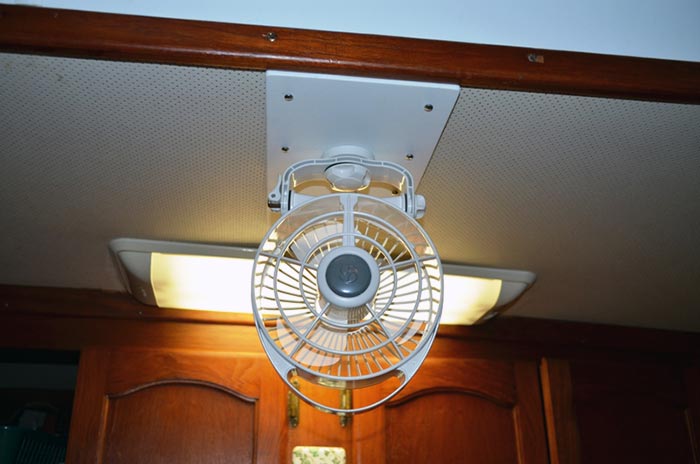
The completed project. Who would ever know what was there?
Liners inside the cabins of boats come in many materials, but they all have one thing in common: Eventually they tear or become damaged. In older boats, even finding the same material may be impossible, and if you do, the job of replacing the entire liner or even a section may be very expensive. Patchwork may be the cheaper and easier way out, but it will probably look like patchwork — and nobody wants that. But if you incorporate another project into the lining repair, you can sometimes disguise the fact that it's patchwork AND get an additional bonus.
For example, on our boat, we had a liner that had been ripped before we owned the boat. Our solution was to cover the problem area with what is essentially patchwork. But you'd never know it because the patchwork has been transformed into a mounting for a new fan.
I purchased a sheet of StarBoard (1/4" x 6" x 12") from West Marine for around $13 (see "Technical Support," below). This material comes in several thicknesses and colors, including white and black. It will take screws (wood or better) and bear weight, depending on thickness and use. It's high-density polyethylene designed to resist saltwater, chemicals, and sunlight. It won't rot or delaminate, and is easily cut, routed, shaped, and drilled, using standard tools. It has a durable surface, which easily cleans.
Technical Support
Degree of difficulty:.
Easy to moderate
- Multi-meter
- Wire-crimping tool
- Electric drill and bits
- Butt connectors
- Screwdrivers
- Headlamp and shop lights (optional)
Materials & Cost:
- StarBoard $13
- Butt connectors and six stainless wood screws $5
Project Cost:
$98 (based on West Marine pricing)
Approximate Yard Time/Cost:
This is a straightforward job and shouldn't take a pro more than an hour or so. The national average cost for a marine electronics installer runs about $80 an hour but many have minimums, so you can plan on saving around $100 by doing the work yourself.
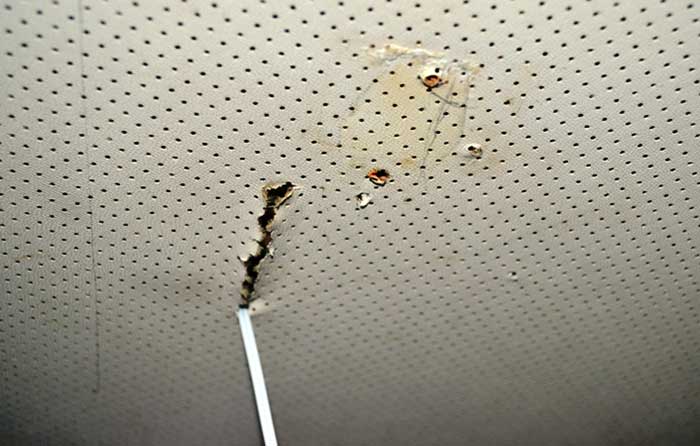
The problem: ripped dirty headliner.
I purchased a sheet just large enough to cover the damage. All I had to do was screw it onto the strip of plywood in the overhead, to which the liner material was attached. I predrilled and used pan head screws. I could have countersunk the screw holes and used oval-head screws, but preferred to not use this slightly weakening process. The material is durable enough that washers weren't needed. When I attached the material, the tear disappeared. But the area, of course, no longer matched the surrounding areas.
We needed a fan in that area, anyway, so I purchased one for around $80 from West Marine. Prior to screwing on the StarBoard, and using the base of the fan as a template, I drilled holes appropriately sized to securely thread the mounting screws that came with the fan and drilled another hole through the StarBoard, behind the fan mount, to take the wire. I taped the fan wire ends to avoid separating the strands and carefully pulled the wires through that hole and pushed them underneath the lining, making sure they were not lying in an area where they would be compressed or where abrasion could occur.
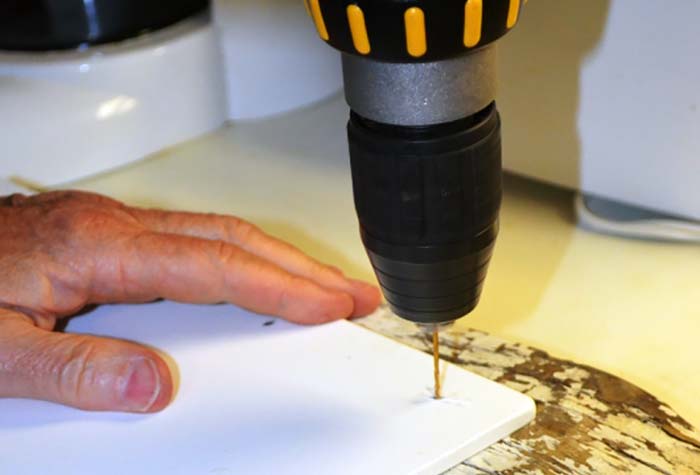
Predrilling StarBoard.
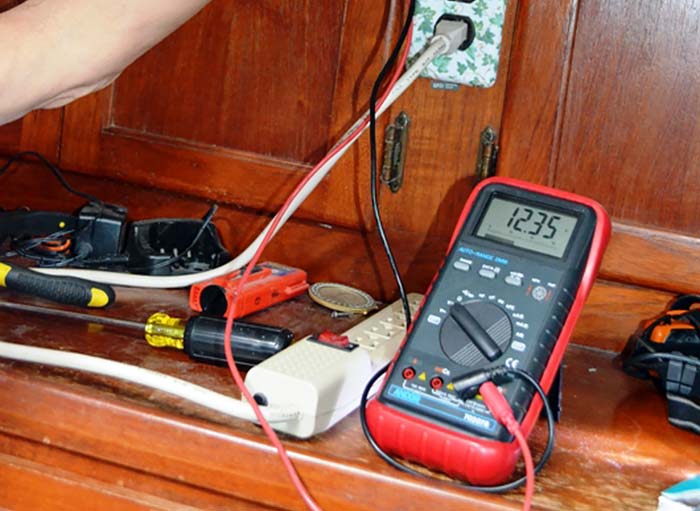
Testing existing wire for polarity and current.
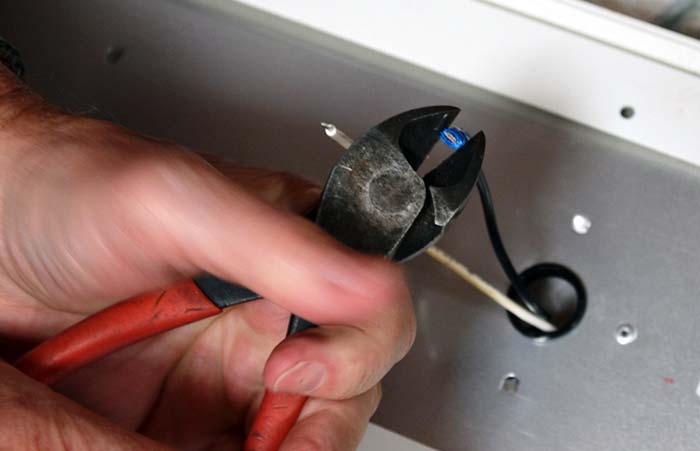
Uncrimping old butt-end connector with careful pressure from dull wire cutter.
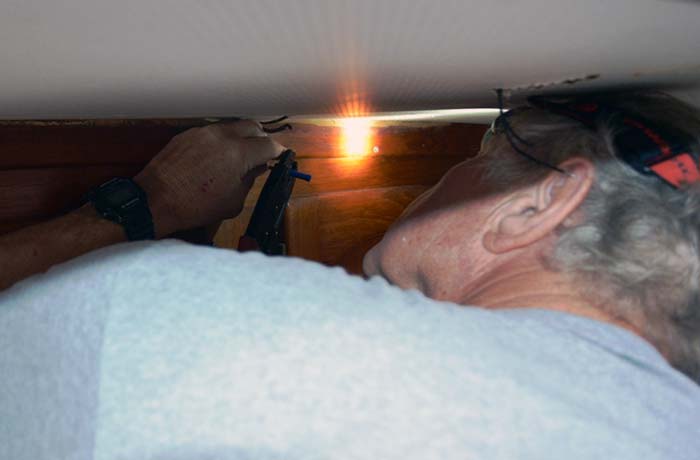
Streamlight 3AA Haz-Lo headlamp lights tight area.
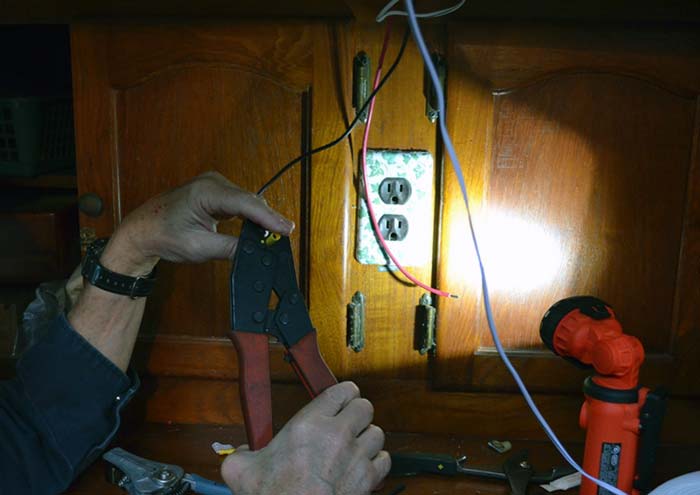
Work light floods dark area. Use quality crimping tools.
With a Volt-Ohm Meter, I tested voltage for the old 12-V DC wiring leading to the area behind the adjacent bulkhead to be sure polarity hadn't been reversed by someone in the ancient past, and then again to be sure power was indeed gone after I flipped the breaker. This wire would've been too short if I cut off the old connectors, so I removed them by carefully compressing them at the point of the crimp with a crimping tool. Next I connected the new fan wires, using tinned butt-end connectors, to that existing wire behind the bulkhead. This work was close to and inside the bulkhead, so I used a Streamlight Knucklehead worklight and a 3AA HAZ-LO headlamp for good lighting. The existing wire was of more than adequate gauge to handle the tiny load of the fan and was already protected by an appropriately sized circuit breaker. The new fan's wires were long enough to allow this work before mounting the fan — a feature I always insist upon when buying something to be installed.
I finished the job by screwing the StarBoard, with fan base attached, to the overhead, attaching the fan and snugly and securing the wire. Now the rip is covered, a smart-looking fan is mounted in its place, and the mounting looks nothing like a jury-rigged repair but a nicely thought-out and properly executed fan mount. Only you and I know it was never originally planned that way!
Plastic Or Wood?
There are several versatile synthetic products now on the market that can be used in place of wood for many boat projects. They're easy to work with, using simple woodworking tools, and easy to hand-sand. Examples include StarBoard by King Plastic , and CMG and KOMATEX by Kommerling . StarBoard and CMG are more robust for mounting purposes. CMG is claimed to also accept fiberglass. Komatex, depending on thickness, can be very flexible and easier to fit, but is less appropriate for structural or mounting purposes.
Related Articles
The truth about ceramic coatings for boats.
Our editor investigates the marketing claims of consumer-grade ceramic coatings.
Fine-Tune Your Side Scan Fishfinder
Take your side-scanning fishfinder off auto mode, and you’ll be spotting your prey from afar in no time
DIY Boat Foam Decking
Closed-cell foam flooring helps make boating more comfortable. Here’s how to install it on your vessel
Click to explore related articles
Technical Editor, BoatUS Magazine
One of the top technical experts in the marine industry, Tom Neale, BoatUS Magazine Technical Editor, has won nine first-place awards from Boating Writers International, and is author of the magazine’s popular "Ask The Experts" column. His depth of technical knowledge comes from living aboard various boats with his family for more than 30 years, cruising far and wide, and essentially learning how to install, fix, and rebuild every system onboard himself. A lawyer by training, for most of his career Tom has been an editor and columnist at national magazines such as Cruising World, PassageMaker, and Soundings. He wrote the acclaimed memoir All In The Same Boat (McGraw Hill), as well as Chesapeake Bay Cruising Guide, Vol. 1. These days, Tom and his wife Mel enjoy cruising their 2006 Camano 41 Chez Nous with their grandchildren.
BoatUS Magazine Is A Benefit Of BoatUS Membership
Membership Benefits Include:
Subscription to the print version of BoatUS Magazine
4% back on purchases from West Marine stores or online at WestMarine.com
Discounts on fuel, transient slips, repairs and more at over 1,200 businesses
Deals on cruises, charters, car rentals, hotel stays and more…
All for only $25/year!
We use cookies to enhance your visit to our website and to improve your experience. By continuing to use our website, you’re agreeing to our cookie policy.
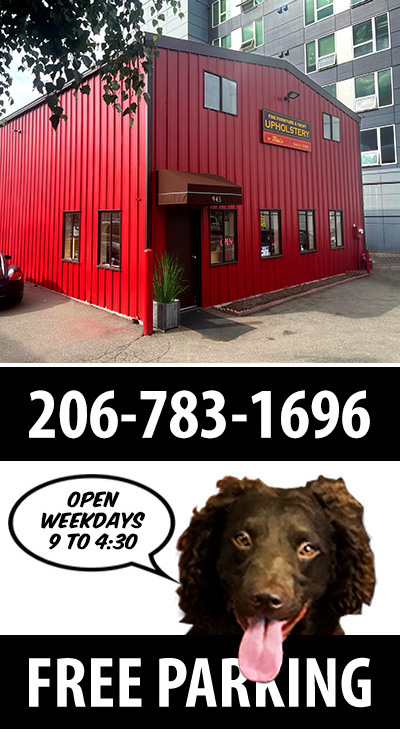
206-783-1696
Open M-Th 9 to 4:30 | Friday 9 to 4 Closed Weekends 945 N 96th Seattle, 98103

Mac's Upholstery
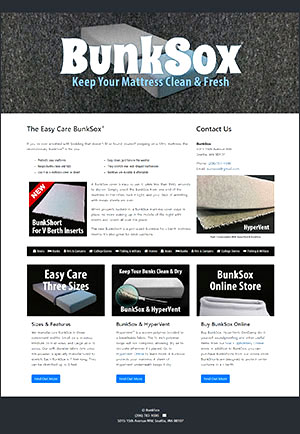
Custom Boat Headliners & Hull Liners
Condensation, moisture and mildew can be hard on boat upholstery. Puget Sound boat owners count on Mac's Upholstery for the finest interior and exterior marine upholstery. We sell boat headliner fabric. We also specialize in repairing and replacing boat headliners and hull liners.
Custom Manufactured Hull Liners
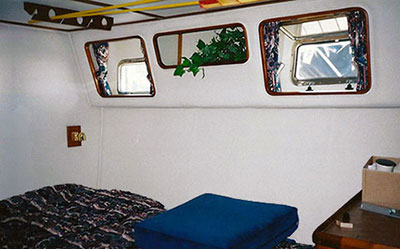
A hull liner is one of those things you never notice unless it's torn, stained or delaminating. If the liner is damaged, your cabin is never going to look its best.
A new headliner or hull liner is among the most economical ways to upgrade your boat. In addition to brightening the cabin, a new liner covers stains, provides insulation and enhances the value of your watercraft.
Custom Installed Boat Headliners
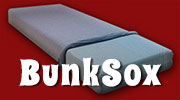
Fight Condensation
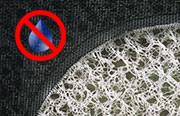
Mac's Upholstery is Puget Sound's leader in custom marine headliners and hull liners.
Years of fabricating and installing hull liners has taught us that every project is different. Properly repairing a boat headliner or replacing a hull liner requires a series of steps. You can't just tack on new fabric and call it good.
After stripping the old liner and fasteners, the hull needs to be thoroughly sanded and prepped. In some cases we'll recommend a padded liner, in other cases a thin fabric works fine.
Whatever fabric you choose, it needs to be cut and attached with great care, especially when the surface is concave or irregular. You only have one chance to get it right!
Environmental conditions impact the life of a liner, but when it's installed by the professionals at Mac's, you can expect a hull liner or headliner to last up to 15 years.
In most cases, our technicians do the work dockside and onboard your watercraft. For trailer boats, it can be more cost-effective to restore the hull liner or boat headliner at our Ballard shop. Wherever we do the work, you can count on Mac's Upholstery to use the finest materials and the latest technologies to repair or replace your boat liner.
Hull Liner & Marine Headliner Installations
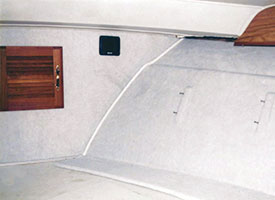
© Mac's Upholstery
Open Monday to Thursday 9:00 to 4:30 | Friday 9:00 to 4:00 | Closed Weekends
945 N 96th Seattle, WA 98103 206-783-1696 [email protected] Please include phone number when emailing.

WNCN Raleigh
Headliner doesn't appear at Durham’s Bimbé festival
Posted: May 19, 2024 | Last updated: May 19, 2024
More for You
We Ordered 7 Fast-Food Breakfast Sandwiches to Find the Best One
Philadelphia university president reacts after at least 75 anti-Israel protesters descend on campus
These 12 States Are Banning the Sale of Gas-Powered Cars
This type of supplement may increase heart disease risk, new study finds
Gayle King’s Sports Illustrated Swimsuit Featured the Detail Shoppers Call “Incredibly Flattering”
The Common Household Ingredient That Can Unclog Slow-Draining Sinks And Tubs
Move Over Kraft, This New Boxed Mac and Cheese Is All I Want for Dinner
You could get in big trouble for throwing these items in trash
The New Math of Driving Your Car Till the Wheels Fall Off
Fans Demand NBA Take Action Against NBA Ref After Thunder-Mavs Game 6
Your Blood Type Affects Your Risk of Early Stroke, Scientists Discover
TV Legends: The Top 25 Timeless Characters
Scientists discover metal from the 'lost city of Atlantis'
Finance expert sounds alarm over 'spaving' trend: An old 'trap' with a new name hitting your wallet
The Largest Waterfalls in the United States
Jennifer Aniston Shares The ‘New’ Hair Product She ‘Loves’ To Tame Frizz
20 Best Sandwiches in America You Need to Try At Least Once
What life is like in the world’s happiest country, from a 28-year-old who left the U.S. for Finland
Putin's 'Revenge': Georgia's Jailed Ex-President Urges West to Act
The Greatest Creature Feature Movies of All Time

- Forums New posts Unanswered threads Register Top Posts Email
- What's new New posts New Posts (legacy) Latest activity New media
- Media New media New comments
- Boat Info Downloads Weekly Quiz Topic FAQ 10000boatnames.com
- Classifieds Sell Your Boat Used Gear for Sale
- Parts General Marine Parts Hunter Beneteau Catalina MacGregor Oday
- Help Terms of Use Monday Mail Subscribe Monday Mail Unsubscribe
new headliner or just paint the ceiling
- Thread starter vincent
- Start date Feb 25, 2008
- Brand-Specific Forums
hi i have a 28 year old seidelmann 37 the head liner is moldy and coming down in so many spots , especialy in the v-berth . i am thinking of ripping it all out and painting it. any good ideas out there . thanks roundhouse
very recent archive Vincent- your exact question came up within the last 2 weeks, maybe less. There were several (maybe a dozen or more?) replies from sailors that had redone their headliners. Check the archive- alot of good responses. Fair Winds tim
Rip it out.... then live with it a little while. Use your imagination to picture a painted surface or another headliner. Our boat's previous owners put in a nice tongue and groove wood ceiling. Looks great, but to access any of the deck hardware bolts I have to disassemble the boards one by one.
headliner s 37 I ripped the liner out and painted it white it look fine to me.
rip it out thanks everyone, i am going to rip out the v-berth first, clean it up . remove all the foam , some patching around the hatch area, then i can paint it or some thing else. any thing is better than what is there now, thanks again , vincent, roundhouse...
sand sailor
me too! I had the same conditions in a 1986 Seidelmann 295 that I am refurbishing. Although it was a lot of work, I removed the lining in total throughout the entire boat, down to the fiberglass, including the side liner. It was so worth the effort, and left me with "a blank canvas" to work with. I have looked at over 30 boats to compare the various types of coverings used by manufacturers, and it basically comes down to a matter of personal taste. Being in the northeast, I am opting for something with an R value, rather than a sheet extrusion product. Unfortunately, the fatal flaw in Seidelmann boats is the foam backing on an otherwise quality liner. With time, the foam breaks down to a powder, the adhesive which held the liner up by means of adhering to the foam becomes useless as the foam separates from the liner itself. The effort required to do it right is well worth it, and regardless of what you replace the liner with, the finished product makes the boat "look like new". One final tip, leave the fiberglass bare long enough for a good rain soaking of the boat, locate and identify the source of any leaks, and deal with them before you install the replacement liner material.This will insure that the underside of whatever you do use remains high and dry, and the lifetime of the liner will be significantly longer.Good luck, and keep us posted! Sully
- This site uses cookies to help personalise content, tailor your experience and to keep you logged in if you register. By continuing to use this site, you are consenting to our use of cookies. Accept Learn more…
Local News | Report on Key Bridge collapse raises questions…
Share this:.
- Click to share on Facebook (Opens in new window)
- Click to share on Twitter (Opens in new window)
Baltimore Sun eNewspaper
- Anne Arundel County
- Baltimore City
- Baltimore County
- Carroll County
- Harford County
- Howard County
- Sun Investigates
- Environment
Breaking News
Local news | preakness 2024: seize the grey goes wire-to-wire, outruns mystik dan in 149th running, local news | report on key bridge collapse raises questions with potential legal ramifications.

Nor was the ship running on contaminated fuel, which some experts postulated as a cause for the 984-foot Dali losing power twice as it approached the span in the early morning of March 26.
But the revelation from federal investigators that the Dali experienced two complete power outages about 10 hours before its ill-fated departure raised new questions about how the vessel’s crew responded to the electrical failures, who was informed of the blackouts — and whether the vessel should have set sail.
While it eliminated some possible factors behind the bridge collapse, the preliminary report released Tuesday by the National Transportation Safety Board left other questions unanswered about the tragedy that killed six construction workers , took out a piece of Baltimore’s skyline and disrupted its bustling port.
Experts are divided in their interpretations of the report, but say the answers investigators dredge up could have profound implications both for understanding the tragedy and for an ongoing legal battle involving the Singaporean companies that own and operate the vessel.
“It raises red flags that they had prior power outages,” said Baltimore attorney and maritime law professor Charles L. Simmons Jr.
“The question is who was told about these issues?” added Alexander M. Giles , another Baltimore maritime attorney, in a separate interview. “And what was done to resolve these issues before the vessel left?”
In testimony Wednesday before a congressional committee , the chair of the National Transportation Safety Board, Jennifer Homendy, distinguished between the two March 25 power failures and the two on March 26 as the ship approached the Key Bridge, calling them “mechanically distinct.”
The first two took place during routine maintenance while the vessel was still docked at the Port of Baltimore’s Seagirt Marine Terminal, the preliminary report found. After those two, the crew switched to a different transformer, one that had not been used in “several months.” Homendy pointed to that change as a line of continued inquiry for investigators.
“Switching breakers is not unusual,” she said, “but may have affected operations the very next day on the accident voyage.”

The cause of the two March 26 blackouts is less clear. The preliminary report describes that electrical breakers “unexpectedly opened” when the Dali was about three ship lengths from the Key Bridge.
Power was temporarily restored, but then breakers opened again, causing a total loss of power roughly 1,000 feet from the bridge. The crew would regain electrical power, but not propulsion, before striking a bridge pier, sending the 1.6-mile span tumbling into the Patapsco River and killing the workers filling potholes on the bridge.
Thomas Roth-Roffy, a Coast Guard-licensed chief marine engineer who investigated maritime disasters for the NTSB for almost 20 years, initially thought there were no conclusions to be drawn from the distinguishable power outages. But after reviewing the report more carefully, he believes there may be an underlying cause.
“It almost seems like it’s not a problem with the individual breakers, but with the control arrangement for the power management system,” Roth-Roffy told The Baltimore Sun.
Examining the ship’s electrical system will be key moving forward, Homendy told lawmakers, noting that her investigators have been working closely with Hyundai, which manufactured the equipment and the ship, to replicate some of the problems seen March 26. Investigators said in the report they plan to continue to evaluate “the design and operation of the Dali’s power distribution system,” including its breakers.
The NTSB intends to determine “what happened with the electrical system on the accident voyage,” Homendy told the congressional committee. “What happened in those two blackouts?”
The preliminary report said in a footnote that the NTSB is “not aware” of any other power outages aboard the Dali in Baltimore or at its prior two stops in Newark, New Jersey, and Norfolk, Virginia. Federal investigators secured the Dali’s voyage data recorder, which functions like a simplified version of an airplane’s “black box,” and its hard drive, and said it contains 34 days of data.
“If this had been some sort of common occurrence, then it should’ve been a red flag,” said former merchant mariner Sal Mercogliano. “My question is: This happened the day before, what happened the day before that? Is this a common instance with this ship and this crew?”
In its report, the NTSB attributed the first of two in-port power outages to human error, saying a Dali crew member accidentally shut an exhaust line from one of the ship’s generators, causing it to stall. The second blackout resulted from a lack of fuel pressure to a different generator.
Roth-Roffy said he was surprised that the NTSB report didn’t identify which of several potential factors caused the low fuel pressure.

Michael Buckley III, chief cargo ship engineer for the shipping company Maersk Line Ltd., said he could justify leaving port after a power outage caused by human error, assuming the member of the crew who erred owned up to the mistake and his explanation checked out. Maersk Line is a U.S. subsidiary of the Danish shipping conglomerate Maersk that chartered the Dali for its cargo operations.
“The second one, on low fuel pressure, I’m going to dig really deep to make sure before we leave port that whatever caused that low fuel pressure is fixed,” Buckley said.
According to the NTSB preliminary report, a senior pilot and an apprentice pilot boarded the Dali about 12:05 a.m. March 26. The captain reported the ship was “in good working order,” the report said, and two tugboats pulled the vessel from the dock about 30 minutes later.
There’s no indication in the report that the pilot was informed of the power outages , or that the crew shared the prior day’s events with the Coast Guard.
“If they had two blackouts at the dock, the pilot should’ve been informed of that before the ship sailed because the pilot’s not going to risk his license and he’s going to call the Coast Guard,” Buckley said.
Federal law requires a vessel to report to the Coast Guard when it loses power, propulsion or steering in U.S. waters, but it’s unclear if that regulation applies when a ship is docked.
A Coast Guard spokesman said the agency was not made aware of the Dali’s power outages in port, but declined to “comment on any legal obligations or make any conclusions related to the cause of the marine casualty.”
“This information will be made publicly available at the conclusion of the investigation,” said the spokesman, Lt. Luke Pinneo, referring to a Coast Guard probe that is running in tandem with the NTSB investigation.
Ships experienced complete or partial losses of propulsion, steering or power 42 times in Maryland waters between 2021 and the middle of April, The Sun previously reported . Many of those ships appeared to report such incidents to the Coast Guard as occurring at or near berths in the Port of Baltimore. The Dali did notify the Coast Guard, through a pilots’ dispatcher, about the March 26 power outage as it approached the bridge, the NTSB report said.
Mercogliano and Buckley described the period of time when a ship is not underway as something of a “gray area.” In separate interviews, they said it’s commonplace for a ship’s engineer and crew to resolve their mechanical or electrical problems, but emphasized that it’s critical to be sure it’s fixed before departing.
“Everybody’s under pressure to move that ship — time is money,” Buckley said. “To basically — I’m not going to say lie, but if you’re pretty sure you got the problem fixed, but you’re not 100% sure, that’s a fine line. I’m not going to do that.”
That’s where legal ramifications come about. Lawrence Brennan, a professor of maritime law at Fordham University’s School of Law, said the “multiple instances of problems with the electrical system” could serve as evidence the vessel was not seaworthy.
“Once you get away from the pier, it gets harder to fix problems,” Brennan said. “But before you leave, you have a duty to ensure that the ship is seaworthy or that you’ve exercised due diligence to ensure the seaworthiness of the ship.”

Days after the bridge collapse, Grace Ocean Private Ltd. and Synergy Marine Pte Ltd., the companies that own and manage the Dali, asked a federal judge to absolve them of liability from the crash or to limit damages to the salvage value of the ship plus the revenue it stood to make from its cargo. They estimated the sum to be $43.7 million.
The Singaporean companies moved under the Limitation of Liability Act of 1851, which was designed to protect the maritime industry.
To be successful, they have to prove they didn’t have “privity or knowledge” that there was something wrong with the ship before it left the berth , said Simmons, who teaches maritime law at the University of Baltimore and University of Maryland law schools and practices at Whiteford, Taylor & Preston.
“The NTSB’s findings that there were prior power outages, those facts are going to be relevant to whether the owner and operator had privity and knowledge about the power issues before it left the terminal, and whether the ship should have left the terminal in the first place or should’ve stayed and more thoroughly addressed the power issues they were having,” he said.
A spokesman for Synergy and Grace Ocean said the companies extend their “deepest sympathy to all those impacted by this incident,” but declined further comment, citing ongoing investigations into the bridge collapse.
More in Local News

News Obituaries | Judith ‘Judy’ Oppenheimer, veteran journalist and author, dies

Music and Concerts | Preakness 2024: Headliner Jack Harlow lovin’ on Baltimore as he shouts out Lamar Jackson, Orioles

Local News | 2024 Preakness Stakes race | PHOTOS

Local News | Dali cargo ship, which crashed into Key Bridge, is set to be refloated Monday morning
The WNBA has been building toward this moment. Can it capitalize?
A generation since it launched, the WNBA is looking to make the most of its rise in popularity — and the arrival of a rookie star.

Cynthia Cooper thought girls were going to dream new dreams the first time she glanced into the stands during the inaugural WNBA season and saw a little girl wearing her No. 14 Houston Comets jersey in 1997. Even then, Cooper knew this new league would allow her to prop up the game before she — or any of her peers — could truly profit from it.
As she observes the WNBA now — with record viewership last season, the most-watched draft ever, teams set for charter flight services and some owners investing in practice facilities solely for their teams — Cooper doesn’t feel envy, only pride.
“My number one goal,” said the winner of the WNBA’s first two regular season MVPs and first four Finals MVPs, “was to lay the foundation for this moment that’s happening right now.”
Women’s basketball, on both the collegiate and professional levels, has been riding a wave of popularity — one that Cheryl Reeve, coach of the U.S. women’s Olympic team and the Minnesota Lynx, dubbed “a tsunami” following the success of the NCAA tournament and its biggest star, Iowa’s Caitlin Clark . A ratings magnet and a dynamic scorer with near-limitless shooting range, Clark, who will open her WNBA career Tuesday night as a guard for the Indiana Fever, is the leading force behind the current surge — and the headliner of an impressive group of young players with the potential to take the league to new heights.
While there will be considerable curiosity about whether Clark’s electrifying game will translate to the world’s best women’s league, eyes will also be on the WNBA to see how well it can capitalize on what many — including Commissioner Cathy Engelbert — view as a transformational moment.
“There’s always moments in life, especially for this league, where you feel like there’s this momentum,” Phoenix Mercury guard Diana Taurasi said. “We’ve had them in the past, and I think we’ve let it slip through the cracks, but it just seems a little bit different this year.”
The WNBA’s media rights deal expires in 2025, the same year the league is set to expand to a 13th team, located in the Bay Area. Engelbert hopes to eventually become a 16-team league. This moment serves as a chance to elevate the WNBA’s profile, with the aim of paying players salaries that are commensurate with their talent and worth. There is a certain amount of pressure to make the most of the opportunity.
“That’s sort of what women’s history is about — you make advances in a time when the culture makes it possible. And then there’s often a slamming of the door,” said historian Pamela C. Grundy, who co-wrote with Susan Shackelford the book “Shattering the Glass,” about the history of women’s basketball. “This moment, we cannot take that for granted. You can’t say: ‘Oh, it’s just going to be all roses from now on. Big TV ratings and such.’ You hope the league — and people in society in general — will be able to maneuver so it moves forward and this really is permanent change.”
Clark’s popularity is one reason for optimism. Her feisty competitiveness and immense skill have attracted capacity crowds and lucrative endorsement deals from Nike and State Farm, earning a level of mainstream recognition other women’s basketball stars — particularly those who are Black — haven’t in the past. But for her part, she refuses to let herself get overwhelmed by the outsize expectations.
“I still feel like that young kid,” Clark said. “I don’t feel like I’m this big figure that’s larger than life. I just love playing basketball. I continue to remind myself every single day how grateful I am to be here and be in this place.”
New leagues generally need at least a full generation to generate genuine cultural cachet. The timeline for the WNBA’s quest to gain attention and respect for the past 27 years nearly matches up with that of the NBA, which needed more than three decades before stars Larry Bird and Magic Johnson helped deliver it from the dark ages of playoff games being shown on tape delay. Then the table was set for a new level of superstar, Michael Jordan, to propel the league into a different stratosphere.
Jackie Stiles, one of the top scorers in NCAA history when her Missouri State career ended in 2001, believes Clark could captivate audiences the way Jordan did or even the way Stephen Curry does for the NBA’s current era. But this is also a league that has never tried to force-feed a savior to its fans.
Chamique Holdsclaw, Tamika Catchings, Candace Parker, the tandem of Sue Bird and Taurasi, Maya Moore, Brittney Griner and Breanna Stewart, among others, also entered the WNBA with incredible fanfare. But those greats have always graced the court with other elite players, with no shortage of prideful, ornery competitors ready to make any anointed newcomers earn it.
“We have never been a league about one player,” WNBA chief growth officer Colie Edison said in a telephone interview. “We will never be a league about one player.”
Clark is entering a league whose players have increased cultural relevance. The WNBA created player marketing agreements through the most recent collective bargaining deal to assist select players in endorsements and broadcast opportunities. Two-time MVP A’ja Wilson, who is leading the Las Vegas Aces’ pursuit of a third straight championship, recently announced she will have a signature shoe with Nike and has a book on the New York Times bestseller list. Griner is sharing her story from her harrowing experience as a political prisoner in Russia, which required the assistance of the White House for her release, in a new book.
Rookie Angel Reese, whom Clark famously competed against in the 2023 national title game, recently attended the star-studded Met Gala. And it has become the norm to see the recently retired Parker or Chiney Ogwumike providing NBA analysis on television or Jewell Loyd or Jonquel Jones in a State Farm commercial.
These breakthroughs have come on the heels of players being outspoken on social justice issues starting in 2020, including pushing to get a U.S. senator with ties to the league voted out of office for failing to align with their values.
The WNBA, however, has never dealt with a newcomer as popular as Clark, whose shoe deal is reportedly worth $28 million. Stiles recalls the response she encountered as the No. 4 pick in 2001 draft. She had just inked a shoe deal with Nike worth about $25,000 — nearly half her annual WNBA salary — which allowed her to break from the rest of the league’s players who had to wear Reebok. At one point, Stiles said her coach had to pull her aside to warn her about driving to the basket so much, for risk of not making it to the end of the year. Her Hall of Fame career was stymied by injuries.
“I hope there’s no jealousy between the veterans. And they just embrace [Clark] and just know that she’s making the whole league better,” Stiles said.
But progress can sometimes yield a side eye. Engelbert announced before the start of the season that the league would finally begin providing charter flights for all 12 teams, responding to a push from players that has been in the works for years. The optics of the announcement’s timing might not have been the best, because it comes a year after Griner endured harassment while catching a commercial flight with her team — and coincides with the arrival of a marketable White star. It has the potential to be perceived as a slight to the generations of Black women whose talents and sacrifices helped elevate the league to relevance.
Wilson isn’t willing to accept that reasoning. “If we credit this to one person, that’s disrespectful to the sport and the players that have helped us continue to push this,” she said. “I’m just happy that it’s finally here.”
From Rebecca Lobo to Sabrina Ionescu, there have been a number of White players elevated in the WNBA, but none has sought attention at the expense of her counterparts. Cooper is a fan of Clark, she says, and not just because Clark gave her a shout-out during a recent appearance on “Saturday Night Live.” Clark’s success in college gave fans the chance to honor past greats, such as Lynette Woodard, whose efforts were largely ignored at the time.
Whether Clark triumphs or flops, the spotlight won’t have to shine in one place. After leading South Carolina to its third title by beating Iowa, Coach Dawn Staley, one of the WNBA’s pioneers along with Cooper, credited Clark for bringing new fans who could appreciate the sport — her team included. There’s no room for resentment if the pie is widened for everyone else. “All boats rise,” Lynx forward Napheesa Collier said.
The WNBA now has an entire generation of players who were either toddlers at the league’s inception or hadn’t been born. All they have known is that if they put in the work there is a professional league there to platform their talents.
That little girl Cooper spotted in the stands had dreams, and those dreams are becoming reality.
“I’ve never been frustrated. I’ve always understood that that was my position at the time and my plight,” Cooper said. “The moment is happening now because it’s time.”


IMAGES
VIDEO
COMMENTS
DetailsReplacing the headliner in your boat, RV, automobile or other vehicle is a great way to update the look and feel of your boat or automotive interior. This simple fabric refresh can help to modernize and update your boat cabin. There's not a lot of natural light in a boat cabin or RV interior. Removing and replacing dingy, worn-out headliner can also greatly increase the brightness and ...
Back in the 1970s and 1980s, many sailboats were finished with foam-backed vinyl headliners glued directly to the underside of the deck and coachroof molding. If you own such a boat, you're likely to be well acquainted with the problem of the headliner coming adrift as the glue and foam interface breaks down.
DetailsHullBlanket Headliner Carpet Type Sand is a beautiful, non-vinyl headliner. Perfect for marine environments, HullBlanket fabric is durable, stain-resistant, mold and mildew resistant, antistatic and moistureproof. This 100% polypropylene fabric is directional (clear warp and fill orientation) and has a soft, knobby woven look, similar to outdoor carpet.HullBlanket is easy to work with ...
In this vlog we finally get the new headliner in the salon area of our sailboat. We used a tongue and groove style vinyl beadboard found at Home Depot. It's ...
EverSoft™ Pebble Off White 54" Perforated Foam Backed Headliner. Morbern® Seabrook Stinger Bisque 54" Foam Backed Headliner. 1. 2. 3. Shop top-quality headliner fabric for your boat, automobile, or RV. Buy carpet, vinyl, and foam-backed headliner fabric by the yard. Samples available.
In the video below we explore the process of replacing the worn-out and inefficient vinyl headliner in our sailboat's v-berth. The existing headliner lacked insulation, leaving the V-berth vulnerable to temperature extremes. By removing the old one, adding insulation using closed-cell neoprene sheets, and installing a high-quality EverSoft ...
http://search.sailrite.com/?freeText=headliner How to install carpet style headliner or hull liner in your boat. This video will show you the steps needed to...
Install your own carpet style headliner in a boat. This video shows Jim Grant installing hull liner to a quarter berth. Visit Sailrite to purchase your Headl...
Installing the New Headliner. With your new headliner material cut to size, you're ready to begin the installation process. Follow these steps for a successful installation: Apply Adhesive: Following the manufacturer's instructions, apply adhesive to the back of your headliner material using a paint roller or brush.
3: Any stubborn patches can be loosened with a hot-air gun. 4: Before removing a panel, clearly mark its position and orientation - in this case, port lower, with the arrow pointing towards the bow. The hatch trim is unscrewed, and the side facing the bow marked with pencil so the screw holes can be relocated.
Boat Headliner Repairs. Advertisement. Age and abuse can discolor or rip liners in your boat. But Tom's a fan of figuring out innovative repairs. ... In older boats, even finding the same material may be impossible, and if you do, the job of replacing the entire liner or even a section may be very expensive. Patchwork may be the cheaper and ...
Ripped out (Headliner) Ceiling (masonite covered with vinyl) not a bad combo, however, 30 years of wear/tear and occasional drip caused some swell & rot. ... Just for your info, ceiling on a boat is the inside hull covering and the dirt dweller's term for ceiling is the overhead. Likes: FastOlson and william24424. rgranger. Jan 19, 2010 12,425
Replacing Headliner on a Boat It's a lot of frustrating work, but doable. When we bought our vintage ketch, one of the first big projects was replacement of the headliner in the forward compartments which had deteriorated somehow and become tacky. The surface was actually gooey to the touch and scuffed up majorly as a result.
In today's video, we'll be showing you how to install vinyl fabric as the headliner material for your boat cabin walls. We chose to use Naugahyde ® Nauga Soft for our headliner material. Nauga Soft is a supple vinyl upholstery fabric with a look and feel like real leather. It's extremely durable with superior tear strength and abrasion resistance.
Find Headliner and Sail Panel Board Combos and get Free Shipping on Orders Over $109 at Summit Racing! $5 Off Your $100 Mobile App Purchase - Get the App. Vehicle/Engine Search Vehicle/Engine Search Make/Model Search Make/Engine Search Departments; Brands; Savings Central; Contact Us; 1-888-501-9619; Help Center ...
Fight Condensation. Mac's Upholstery is Puget Sound's leader in custom marine headliners and hull liners. Years of fabricating and installing hull liners has taught us that every project is different. Properly repairing a boat headliner or replacing a hull liner requires a series of steps. You can't just tack on new fabric and call it good.
SEE our Project Sailboats Interior Makeover! Our Project Boat Refit and Restoration.We did many projects over the years and in this video we are going to sha...
The primary goal when installing new headliner is to first insulate between each plywood furing strip and then cover the insulation with vinyl for a beautiful cabin interior. We're using Nauga Soft vinyl fabric to wrap our panels. Nauga Soft is a great choice for boat cabins. It offers great durability with the look and feel of real leather.
A fanboy of a supervillain supergroup known as the Vicious 6, Gru hatches a plan to become evil enough to join them. Luckily, he gets some mayhem-making backup from his loyal followers, the ...
Seidelman S37 Slidell, La. Feb 25, 2008. #3. S37 Headliner In exactly the same boat, with the exact same boat. Nice play on words. I have just about decided that what I am going to do is to install a fiberglassed reinforced white plastic. It is 13 bucks a sheet at Home Depot. Should be much easier to clean and take care of than a painted surface.
NTSB Chair Jennifer Homendy speaks March 26, 2024, about the collapse of the Francis Scott Key Bridge in Baltimore. (Kim Hairston/Staff) The cause of the two March 26 blackouts is less clear. The ...
The WNBA's media rights deal expires in 2025, the same year the league is set to expand to a 13th team, located in the Bay Area. Engelbert hopes to eventually become a 16-team league.
Sattler Marine Grade. This 100% solution-dyed acrylic canvas is a great choice for biminis and dodgers, boat covers, and more. Sattler Marine Grade features excellent abrasion, mold and water resistance and blocks 97.5% of harmful UV rays. It's easy to work with and comes in a wide selection of colors to match your boat.
Re-do your boat's seats and headliners with marine-grade upholstery vinyl material from Sailrite, with a range of colors and styles available. ... EverSoft™ Smooth Off White 54" Perforated Foam Backed Headliner. EverSoft™ Smooth Off White 54" Foam Backed Headliner. EverSoft™ Pebble Indoor/Outdoor Green 54" Vinyl Fabric.